How a National Lab in Charge of Nuclear Safety Optimized Its Systems

An experiment being conducted in the National Ignition Facility at the LLNL. Lawrence Livermore National Laboratory
The lab went from having 63 data centers to 18, across its square-mile campus, reducing facility costs and repurposing staff.
Optimized data centers are important for any federal agency, but their significance escalates when those facilities perform high-end computing and science related to national security and nuclear safety.
In 2011, Lawrence Livermore National Laboratory, one of the Energy Department’s 17 national labs, faced a mixture of legacy hardware, aging facilities and too many inefficient data centers, according to Anna-Maria Bailey, program facility manager at Lawrence Livermore National Laboratory.
Based in California, the lab is a high-performance computing and science hub that plays a key role in the safety and reliability of the nation’s nuclear weapons under the National Nuclear Security Administration. But, Bailey said, the lab was spending big to maintain some facilities that were three to five decades old—a problem occurring with increasing regularity across the federal government.
Rather than continuing to spend reactively, Bailey opted for a proactive, holistic approach to improving operations at the lab.
The lab consolidated 63 data centers across its square-mile campus into 18 data centers, reducing facility costs and repurposing staff. Mission critical data and applications were migrated to high-performance computing systems, while less critical apps—though still important for daily operations—were moved to enterprise computing systems. Cloud computing figured heavily into the lab’s strategy, and is used for its enterprise computing systems at the lab.
Bailey told Nextgov while migrating programs can be challenging, people actually pose the most resistance.
“People wanted to be right next to the machine and data—they couldn’t stand the fact that it was a half-mile away,” Bailey said. “It took time. It’s easy to move things; it’s the people you can’t change. It’s a lot like herding cats.”
The lab’s modernization effort is geared toward continually improving operations, and Bailey said one of the keys has been a software platform called PI, developed by OSIsoft. The operational intelligence software brings in various data streams—sensor data, metering equipment, building management systems, energy utility data and other forms—and presents them to users in a common dashboard.
The biggest challenge here, Bailey said, was getting access to all the data. Again, that was more a people problem than a technology issue. She had to maneuver around various chains of command to persuade data stewards to relinquish access to their data.
“It took us about 18 months to get the data,” Bailey said. “The goal was to lower overall power utilization and improve operational efficiencies.”
The results have been striking, Bailey said, with the lab slashing power consumption by 50 percent. Both goals, she said, have been met.
Administrators and managers have access to real-time key performance indicators like total power consumption, power usage effectiveness and IT load. In addition, those metrics can be monitored remotely as simply as through a mobile device.
“Lawrence Livermore National Laboratory is a great example of an agency that did this by taking a holistic approach," said Steven Sarnecki, vice president of public sector at OSIsoft. “They used data to identify areas for improvement within and across multiple operational silos. With one version of the truth and facts, not opinions, they established a clear baseline for performance improvement. Their common operating picture provides not only near term savings but an infrastructure to continue improving operations. They are a model for other agencies striving to do the same.”
NEXT STORY: Why the Vista sunset is not a big deal



